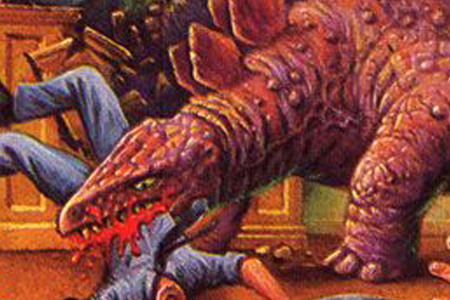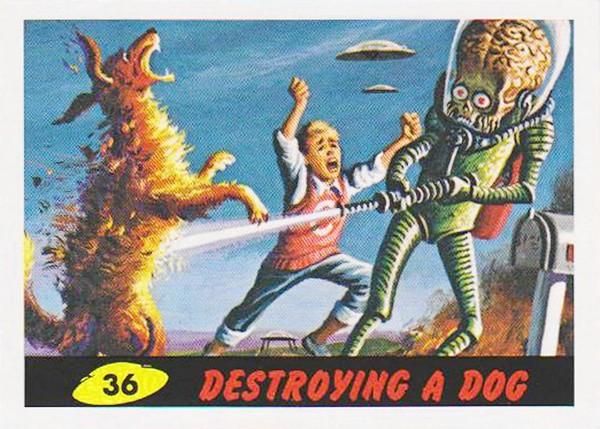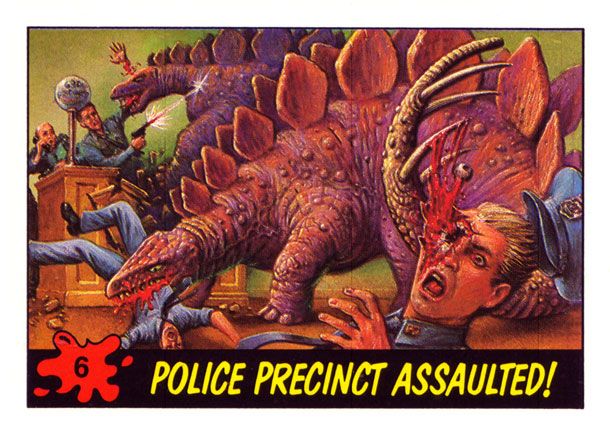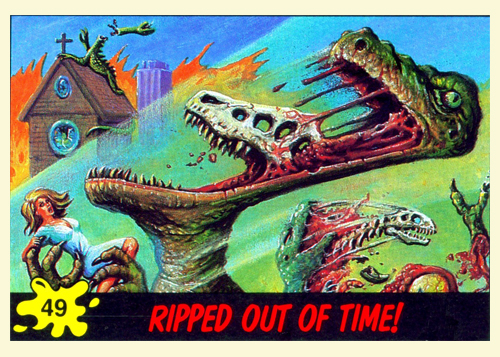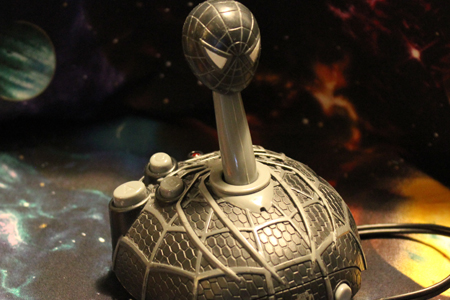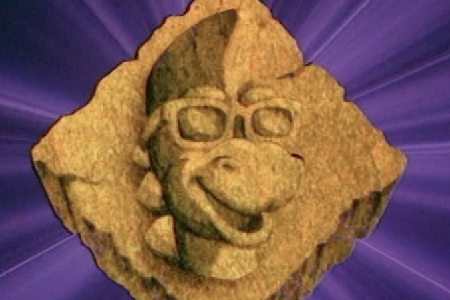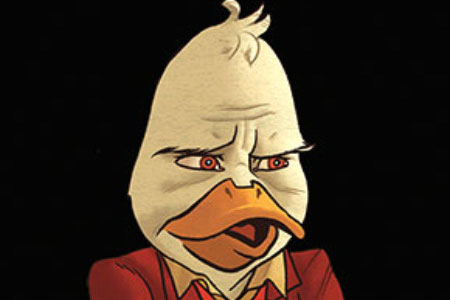
We almost had a Dinosaurs Attack! movie. When the rights to Mars Attacks were purchased in the 1990s, the Dinosaurs Attack! concept was part of the deal. Before the movie could enter production, Jurassic Park was released, frightening producers away from making another blockbuster rampaging dinosaur movie. All of the sexy Goldblums in the world can’t replace what the world has lost, and we still had to deal with 1994’s Tammy and the T-Rex and 1996’s Theodore Rex anyhow.
Like Mars Attacks, Dinosaurs Attack! is another product of Topps’ ultra-violent legacy of disturbing, wonderful trading cards, which started in 1962 with Civil War, a series of bloody, graphic depictions of death and the horrors of history. Bodies riddled with bullet holes, drowning men, and limb-rending cannon explosions that you’d never find in a history textbook populated the set, which was both educational and sensational. This was followed in 1965 by Battle, a set depicting World War II, which had depictions of flying teeth, giant swastikas underneath a looming grim reaper, and small children watching their teacher bleed to death on her desk. In the era of Gilligan’s Island and The Andy Griffith Show, it was an all-too-real reminder of what was probably going on in Vietnam at the time. Whether or not this was some kind of anti-war statement or just a sensationalist money grab is debatable.
So when Mars Attacks came along between these two sets in 1962, the gore was not out of place, especially considering artist Norman Saunders worked on all three sets. Mars Attacks, however, was seen as so outrageous that an outcry convinced Topps to re-illustrate a selection of the cards to be less horrific; under pressure, they halted production before these cards could be reprinted. The property went dormant for almost 20 years before the cards were reprinted in 1984, and then a few times after that. But in the new Garbage Pail Elm Street Nightmare era of the 80s, Topps took another swing at a set of gore cards. In 1988, Dinosaurs Attack! was released. It was a swing and a miss; the set failed on a large enough scale that a companion three-issue comic series was cancelled after issue #1. But the set is really a hidden gem among the trading card boom of the 80s and 90s. A set can be picked up for just a few dollars today. (Don’t bother buying a case of packs; there are no chase cards to hunt down.)
Dinosaurs Attack! tells a self-contained story, just like the previous Mars cards do. Scientists board a space station and open a portal through time, and suddenly, dinosaurs start appearing on Earth. For 40 cards, they kill helpless people in the worst ways imaginable. Humans rarely get the upper hand against the gigantic and scientifically inaccurate monsters. Somewhere in the middle of the story, the lead scientist is visited by a reptilian alien in his sleep who tells the him that dinosaurs have no souls. By the end of the story, a literal dinosaur Satan unexpectedly appears on the other side of the portal, snatches the scientist, and the portal is closed. It is off the wall, butts to nuts bonkers, and it’s amazing. It’s sci-fi at its most inexplicable; sometimes things happen that just can’t be explained yet.
The gore ranges from goofball to nauseating, and the back of many of the cards present the story in the form of newspaper clippings. Even after the President is devoured on live TV, 24% of the nation still believes that the whole thing is a liberal hoax, which seems ridiculous, but also extremely optimistic numbers viewed through the dirty, broken window of 2020. Some cards are backed with memorabilia, like a bloodied wedding reception invitation paired with a scene where a bride and groom are being thoroughly triceratopsed, and others are backed with photos of fake news interviews. And there are 11 stickers too, which is super cool.
It’s hard to say why these were a flop. Maybe they just didn’t stand out against the McFarlane Spider-Man, animated Teenage Mutant Ninja Turtles and 1989 Batman movie cards that these would have been displayed with. It could be that cards from a Tim Burton movie ultimately overshadowed Dinosaurs enough that a Burton-directed Dinosaurs wasn’t strong enough to face Jurassic Park in the theaters. It could also be that the companion comics overcomplicated an otherwise exciting story, and started out in the worst possible way.
Instead of a cool sci-fi drama about dino-massacres, we get an excruciating exploration of a crumbling marriage. Dinosaurs don’t actually appear until page 25, after it’s been established that scientific superstar Elias Thorne is not only a genius, but a telekinetic with some kind of split personality. Six pages detail the flight to the space station, which was previously covered in one mercifully short trading card. We learn about Thorne’s dead brother, who never really comes up again. It becomes dense in a way that doesn’t seem to appeal to the same audience as the cards, but it’s an inventive project nonetheless. And it’s a mature foundation for a larger story, even if it wasn’t immediately gripping.
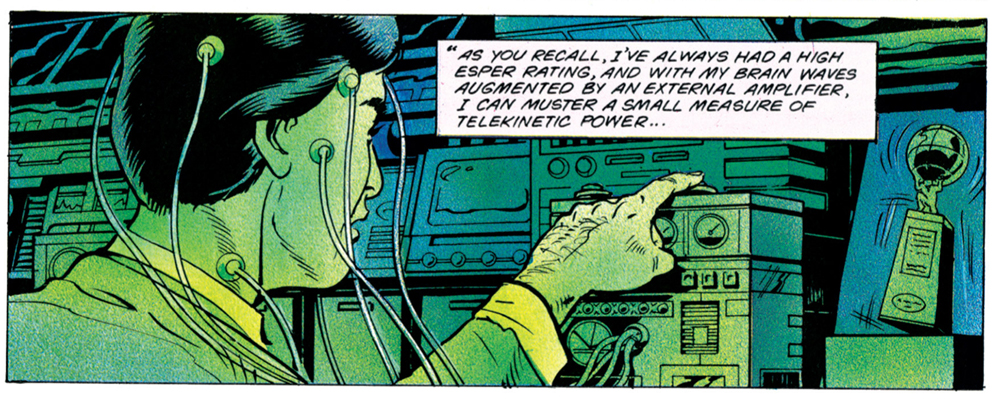
The story, originally planned to be a trilogy but expanded to five books when the project was revisited in 2013, fills in all of the spaces between the cards. The pages switch between traditional illustrations and painted illustrations; for dino-scenes that would appear on cards, paintings take over. There are panels taken directly from the card set, and as Dr. Thorne is discussing viewing different time periods, the page actually showcases some paintings from the aforementioned Civil War and Battle cards, in a neat little Easter egg that ties everything together. Tying everything together even more are the recent Mars Attacks card sets, which introduce the idea that Martians and dinosaurs team up and time travel to attack history itself, sealing the idea that all of these sets exist in the same canonical universe.
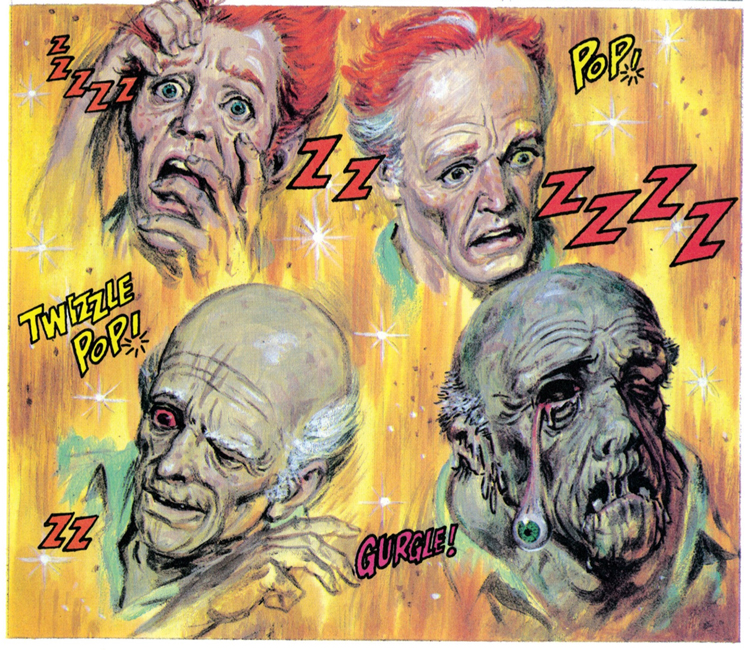
The card illustrations are fun and energetic, done by true masters of the art. Norman Saunders built the foundation for these cards with all of the work he’d previously done for Topps, and the legacy is continued adeptly by the concepts of Gary Gerani, the pencils of Herb Trimpe, and the paintings of Earl Norem and an artist known as XnO. It’s all an original idea that deserved more attention that it got, but thankfully, these are resurfacing as a cult favorite today. Get ’em before they blow up. They don’t take up a lot of space, and if you like horror and mostly-lighthearted gore, these are perfect.
All comic images are copyright Topps & Eclipse Comics and presented here for the purposes of criticism & commentary.
 C. David is a writer and artist living in the Hudson Valley, NY. He loves pinball, Wazmo Nariz, Rem Lezar, MODOK, pogs, Ultra Monsters, 80s horror, and is secretly very enthusiastic about everything else not listed here.
C. David is a writer and artist living in the Hudson Valley, NY. He loves pinball, Wazmo Nariz, Rem Lezar, MODOK, pogs, Ultra Monsters, 80s horror, and is secretly very enthusiastic about everything else not listed here.
